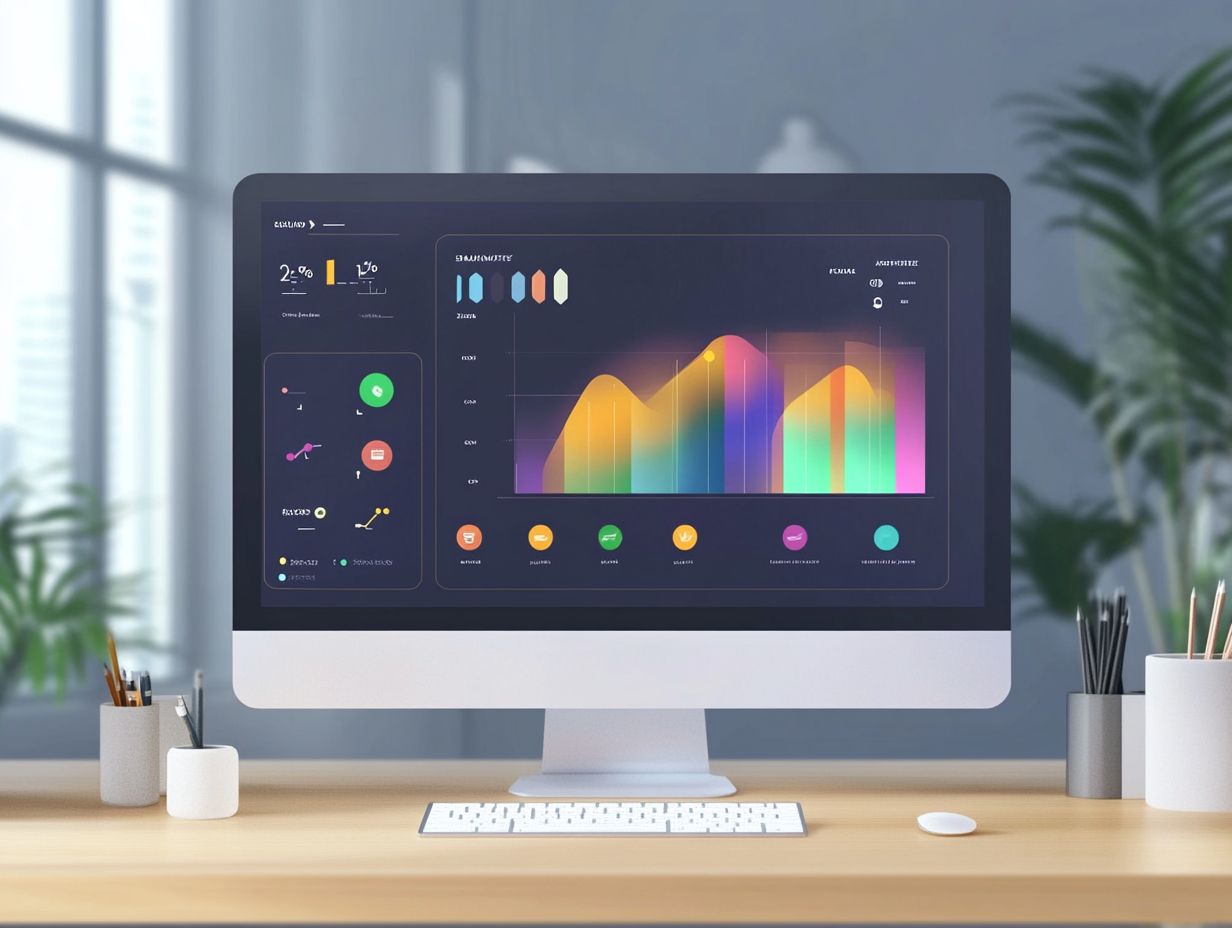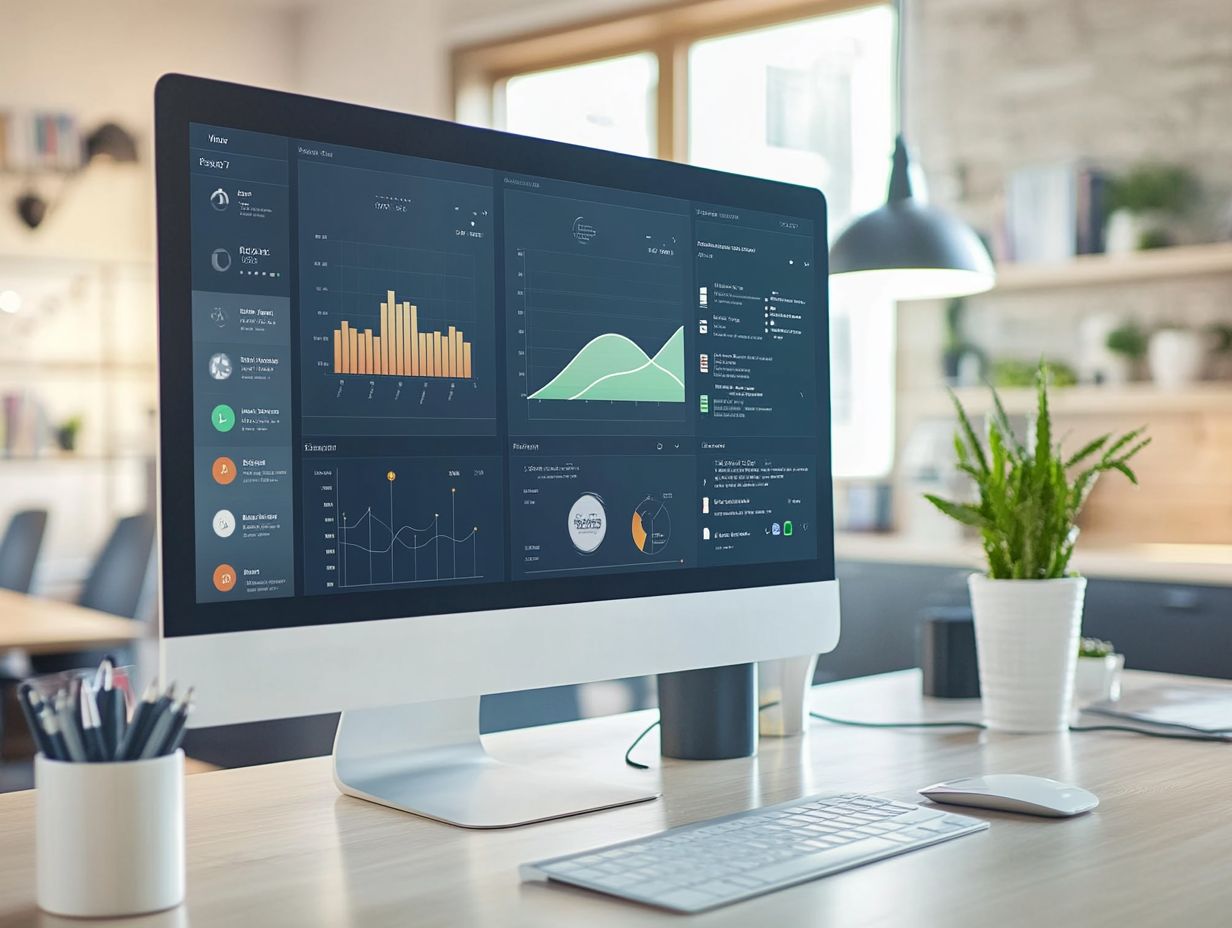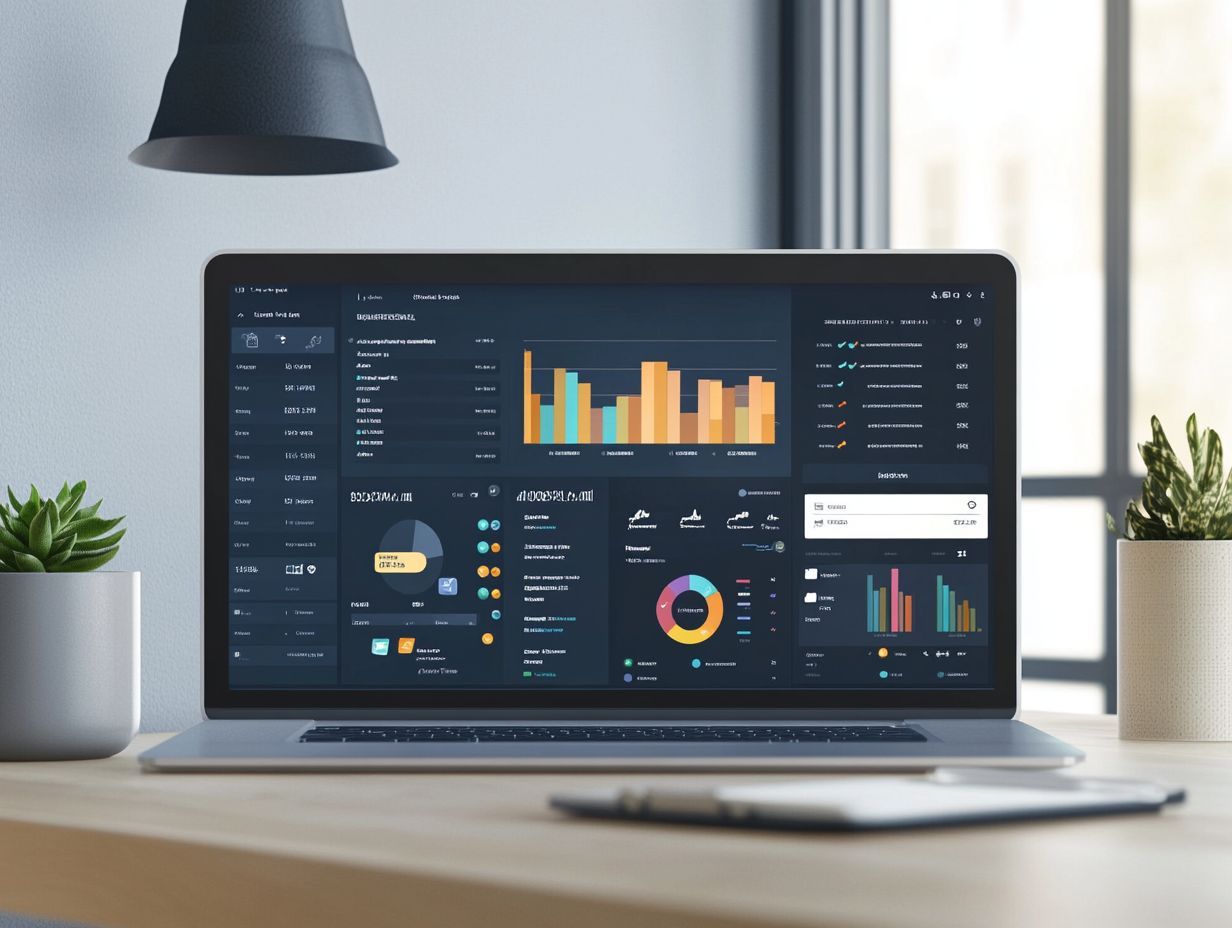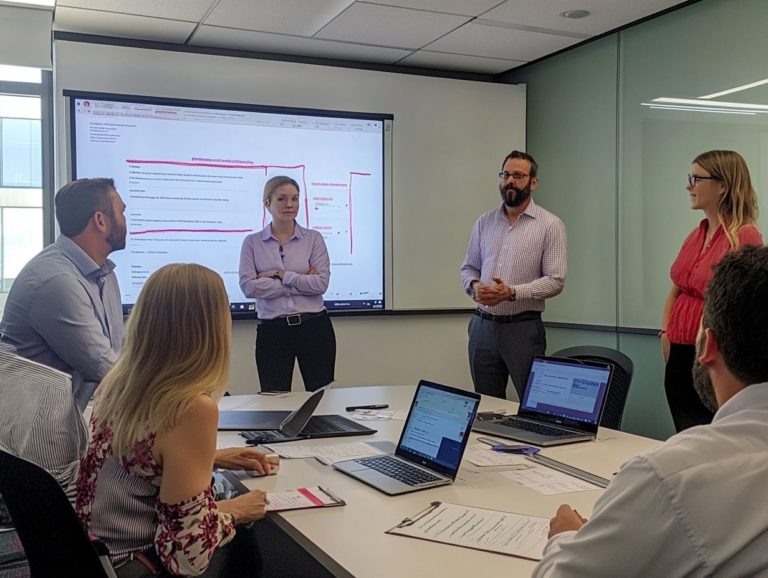Essential Features of Performance Management Software
In today s fast-paced business environment, mastering effective performance management is essential for unlocking employee potential and propelling organizational success.
This exploration delves into the key features of performance management software that can elevate your HR practices to new heights. From goal setting and tracking to employee development, data analytics, and effortless integration, each component plays a critical role in cultivating a productive workplace.
Uncover the tools and functionalities that can revolutionize your approach to performance management. Ensure alignment with your company s values while enhancing communication and collaboration.
Contents
- Key Takeaways:
- 1. Goal Setting and Tracking
- 2. Performance Reviews and Feedback
- 3. Employee Development and Training
- 4. Data Analytics and Reporting
- 5. Compensation and Rewards Management
- 6. Alignment with Company Values and Objectives
- 7. Integration with Other HR Systems
- 8. Customizable Performance Metrics
- 9. User-Friendly Interface
- 10. Mobile Accessibility
- 11. Security and Data Privacy
- 12. Scalability for Growing Businesses
- 13. Collaboration and Communication Tools
- 14. Employee Self-Service Features
- 15. Technical Support and Training Resources
- Frequently Asked Questions
- What are the essential features of performance management software?
- How does goal-setting and tracking work in performance management software?
- Why is performance evaluation and feedback important?
- What role does employee development and learning play?
- How does data analytics and reporting benefit you?
- How do communication and collaboration tools enhance performance management?
Key Takeaways:

- Efficient goal setting and tracking is a key feature of performance management software, allowing managers to set clear expectations while employees can track their progress.
- Performance reviews and feedback are important aspects of performance management software, providing a structured platform for communication and evaluation between managers and employees.
- Employee development and training can be facilitated through performance management software, allowing for personalized learning plans and tracking progress towards skill development.
1. Goal Setting and Tracking
Goal setting and tracking are essential elements of a high-performing performance management system. They enable you and your managers to align your objectives with the company’s goals. This fosters an environment of accountability and continuous improvement, especially when using performance management software.
By establishing clear goals, you create a roadmap that directs your individual efforts and integrates them seamlessly into the broader vision of the organization. Utilizing key performance indicators (KPIs) allows you to measure your progress accurately and identify areas that may need adjustment or further focus.
Performance tracking tools are essential for monitoring metrics and enabling real-time adjustments. Incorporating 360-degree feedback can significantly enhance the alignment between personal and company objectives. This method provides comprehensive insights into your performance, highlighting your strengths and uncovering opportunities for growth.
Feedback loops ensure that everyone remains aligned, ultimately driving collective success.
2. Performance Reviews and Feedback
Performance reviews and feedback are game-changers for your success! They offer transparent evaluations that enable you to receive constructive criticism and recognition of your achievements within the performance management system.
To elevate this process, organizations can introduce a range of feedback options tailored to your individual needs. Self-assessment tools enable you to reflect on your strengths and identify areas for improvement, fostering a sense of personal accountability. Meanwhile, 360-degree feedback gathers insights from peers, supervisors, and direct reports, providing you with a comprehensive view of workplace dynamics.
Timely and actionable feedback is crucial. It drives immediate improvements in your performance and nurtures a culture of continuous learning. When combined with coaching resources, these strategies significantly enhance your recognition and development, ensuring that you feel valued and engaged throughout your professional journey.
Start implementing these tools today to boost your team’s performance!
3. Employee Development and Training
Employee development and training are crucial for cultivating a culture of ongoing improvement. This is where experts in managing employee performance step in, assessing training needs and implementing effective programs that enhance leadership and skill development.
By harnessing data about employee performance, you can identify specific skills gaps within your organization. Tailor your training initiatives accordingly. For instance, if the data reveals that a team is struggling with project management, you can design customized training sessions to elevate those skills.
Incorporating coaching resources is essential for facilitating employee growth. Mentorship programs and one-on-one coaching sessions ensure that employees receive personalized guidance. Companies like Google and IBM have effectively adopted such initiatives, leading to increased employee productivity and engagement. This shows how crucial a strong development strategy is for your team s success!
4. Data Analytics and Reporting
Data analytics and reporting are essential for optimizing your performance management software. They offer personalized reports that assess employee performance against important measures of success. This enables you to make informed decisions and gain strategic insights.
By leveraging the power of data analytics, you can continuously monitor metrics that reveal trends over time. This showcases both strengths and areas that need attention. For example, you might use analytics to pinpoint high-performing teams and delve into the factors contributing to their success, fostering a culture of best practices throughout your organization.
Uncovering underperformance trends can trigger timely interventions, such as tailored training programs or necessary process adjustments. With performance analytics, you can confidently make data-driven decisions that skyrocket productivity! This ensures that individual efforts align with your broader business goals, propelling long-term growth and success.
5. Compensation and Rewards Management

Compensation and rewards management are essential elements in driving employee engagement and motivation. When you implement effective performance reviews and recognition programs, you ensure that your employees feel valued and accountable for their contributions to the organization.
By prioritizing the integration of compensation management with performance reviews, you cultivate an environment where achievements are consistently acknowledged. Timely recognition not only elevates morale but also ignites a culture of high performance, as employees realize that their efforts directly influence their rewards.
Incorporating accountability tracking mechanisms can act as a significant motivational tool. By monitoring progress and celebrating individual milestones, your employees are more likely to stay committed to their goals. This holistic approach not only enhances overall productivity but also builds a loyal workforce eager to drive the company s objectives forward.
6. Alignment with Company Values and Objectives
Aligning your performance with company values and objectives is essential for fostering a cohesive work environment. Every team member must understand their role in achieving organizational success through an effective performance management system.
To achieve this alignment, consider implementing regular goal-setting sessions that directly connect individual tasks to broader business objectives. For example, your sales team might establish a collective target that aligns with the company s annual revenue goals. Involve everyone in this process to gain insight into how their contributions matter, cultivating a sense of ownership over their work.
Utilizing performance reviews that emphasize achievements in relation to company goals encourages engagement and motivation. This structured approach enhances personal accountability and nurtures a shared commitment to organizational success, ultimately driving higher performance across the board.
Start aligning your team’s goals with company values today, and watch your organization thrive!
7. Integration with Other HR Systems
Integrating performance management software with other HR systems enhances functionality. You gain seamless access to crucial data that supports thorough employee performance evaluations and reporting.
Connecting performance management tools with payroll, benefits management, and training systems streamlines HR processes. This collaboration simplifies administrative tasks and enhances the overall employee experience.
Linking performance data to payroll allows precise adjustments to compensation based on evaluations. Integrating training systems helps identify skill gaps and align development opportunities directly with performance goals.
This enhanced connectivity boosts your reporting capabilities. You’ll gain deeper insights into employee performance trends and make data-driven decisions more effectively.
Discover how integration can elevate your HR processes today!
8. Customizable Performance Metrics
Customizable performance metrics within a performance measurement system allow you to tailor measures of success to your needs. This creates real-time dashboards that reflect employee and team performance accurately.
This flexibility is essential for adapting evaluations to your industry’s dynamics and your team’s objectives.
For instance, in a tech company, you might prioritize innovation and speed, tracking metrics like project turnaround times and the number of new features developed. In contrast, a customer service organization might focus on response times and customer satisfaction scores.
Such tailored approaches offer a deeper understanding of performance, leading to accurate assessments. They motivate employees by aligning their goals with their roles. Successful customization nurtures a culture of continuous improvement and drives your organization toward greater success.
Explore customizable metrics that can transform your performance assessments today!
9. User-Friendly Interface
A user-friendly interface is essential in performance management software. It ensures that you and your managers can navigate tools and resources effortlessly, leading to improved performance outcomes.
When the design is clean and intuitive, it reduces the learning curve. You can engage with the software without feeling overwhelmed. Quick support means you can tackle issues immediately and keep your productivity soaring!
With mobile devices becoming prevalent, mobile support is crucial. Optimized mobile interfaces allow you to interact with the software on the go, boosting accessibility and keeping you engaged in performance management tasks.
Experience a user-friendly interface that enhances your productivity today!
10. Mobile Accessibility

Mobile accessibility in performance management software enables you to engage with your performance metrics and feedback wherever you are. This boosts productivity and provides live updates for continuous tracking.
With this functionality, you can easily view your goals and completion rates, fostering a culture of active participation. Provide input and receive instant feedback, making your experience interactive.
For managers, mobile support is invaluable. It facilitates timely updates on employee performance and engagement levels. Imagine getting push notifications that alert you and your team about achievements or areas needing attention ensuring recognition and support are immediate.
Features like mobile surveys and polls encourage your team to share their thoughts, driving higher engagement and transforming performance management into a collaborative endeavor.
Unlock the power of mobile accessibility for your performance management today!
11. Security and Data Privacy
Security and data privacy are crucial in performance management software. They ensure that sensitive employee performance information remains protected while building trust and compliance within your organization.
To accomplish this, a well-rounded strategy is vital. It should incorporate advanced encryption methods that secure data both in transit and at rest.
By implementing strong rules that decide who can see and change information, you ensure that only authorized personnel can view or manipulate sensitive information. This not only reduces the risk of data breaches but also fosters accountability within your team.
Prioritizing data privacy is essential; it directly impacts employee morale and retention. When your staff feels secure about their data confidentiality, they are more inclined to engage openly in the performance evaluation process.
This ultimately leads to enhanced productivity and collaboration.
12. Scalability for Growing Businesses
Scalability in performance management software is crucial for your growing business. It enables you to adapt to changing needs, ensuring that employee productivity flourishes as your workforce expands.
This adaptability isn t just a luxury; it s a key factor in maintaining your competitive edge in a fast-paced market. As your organization grows, your operational demands will evolve, requiring additional features or increased user capacities.
By embracing scalable solutions, you can onboard new employees effortlessly. You ll implement robust performance tracking systems and cultivate an atmosphere of continuous improvement.
The inherent flexibility of scalable systems enhances efficiency in HR management and unlocks growth opportunities. You can respond swiftly to market demands without stretching your resources thin.
13. Collaboration and Communication Tools
Effective collaboration and communication tools are essential to a performance management system. They enable you to foster team collaboration and elevate employee engagement through enhanced feedback options and shared goals.
These tools improve teamwork. They ensure that information flows smoothly across departments.
By integrating features like real-time messaging, document sharing, and project management boards, you can maintain clarity on objectives and deadlines.
This enriched communication environment cultivates a sense of belonging and motivation among your employees. It significantly enhances productivity.
Tracking outcomes becomes effortless, allowing your teams to monitor progress and make necessary adjustments. This ultimately leads to improved results and elevated overall performance.
14. Employee Self-Service Features
Employee self-service features in performance management software empower you to take ownership of your performance. You can use self-assessment tools and personalized feedback options, cultivating a culture of accountability.
This exciting approach promotes autonomy and significantly boosts your engagement. You feel more invested in your own growth and development.
When you can track your performance and set personalized goals, it fuels your motivation and enhances your understanding. This results in a more vibrant work environment.
Self-assessment tools are pivotal in this journey. They allow you to reflect on your progress, recognize your strengths, and identify areas that need improvement.
Consequently, you actively participate in your development planning, driving both your personal success and that of the organization.
15. Technical Support and Training Resources

Technical support and training resources are essential for maximizing the effectiveness of performance management software. They allow you to navigate the platform confidently and access coaching resources whenever needed.
Responsive customer service is critical, providing timely assistance to resolve issues quickly. When challenges arise, having knowledgeable support teams available can greatly enhance your experience and satisfaction.
Comprehensive training resources such as tutorials, webinars, and user manuals help you understand the software s features better. This support boosts your ability to manage performance effectively and fosters a culture of continuous improvement, driving better outcomes for your organization.
Frequently Asked Questions
What are the essential features of performance management software?
The essential features include goal-setting and tracking, performance evaluation and feedback, employee development, data analytics, and communication tools.
How does goal-setting and tracking work in performance management software?
This software allows managers and employees to set and track individual and team goals, aligning them with the company’s overall objectives. It improves goal visibility, accountability, and progress monitoring.
Why is performance evaluation and feedback important?
Performance management software enables regular performance evaluations, providing a comprehensive view of individual and team performance. To ensure successful implementation, it’s important to consider key considerations for performance management tool adoption. It facilitates timely feedback, promoting continuous improvement and development.
What role does employee development and learning play?
Discover how performance management software helps you grow with exciting learning tools! It offers training modules, coaching programs, and career development plans to support professional growth.
How does data analytics and reporting benefit you?
Data analytics features provide valuable insights into employee performance, helping managers make informed decisions and identify areas for improvement. It also allows easy tracking of progress and identification of high performers.
How do communication and collaboration tools enhance performance management?
Performance management software includes messaging, goal sharing, and performance discussions. For organizations looking to enhance their processes, understanding how to choose the right performance management tool is essential, as these tools promote transparency, encourage regular interaction, and foster collaboration within teams.





